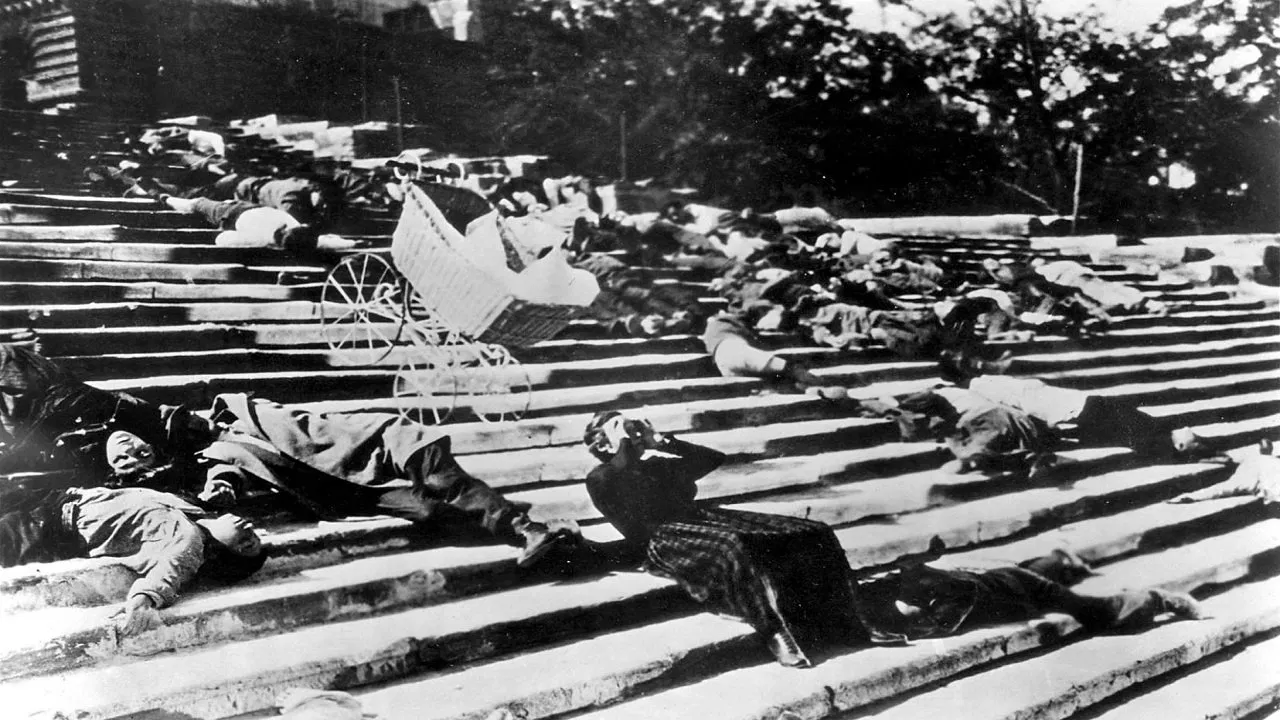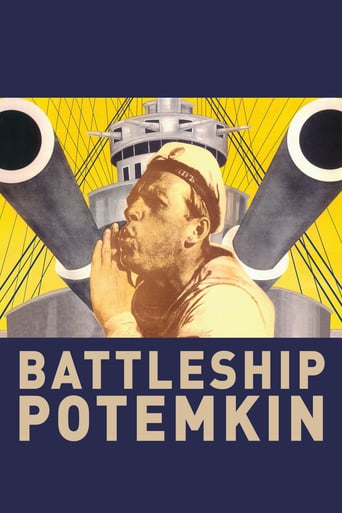

All true cinephiles know about "Potemkin" and how it revolutionized cinematic techniques in editing. We all know about that insane, constantly referenced/parodied Odessa steps sequence, but do we really know WHY "Potemkin" is a GREAT movie? Not just an influential or famous movie, but an actually GREAT movie?Well, in my opinion, the reason that "Potemkin" is so great is its ability to manipulate emotions and have relentless emotional energy and thrills. In its slim 70 minute runtime, more emotional intensity has struck the audience than in most 2 hour action thrillers. This film may be communist propaganda, but its also damn good communist propaganda. I may not agree with the film's political intent, but while I'm watching it I sure do! Using the power of film and visuals, Eisenstein works as a master manipulator, pulling at every string in your body, a surging sea of pain and sorrow exploding across his forever influential screen. Who could ever forget those haunting images? The child being trampled on! The baby carriage falling! The old woman with her shot out! Blood everywhere! Tons of extras falling down these mammoth stairs. Its more thrilling than any horror film you've ever seen, and its damned brilliant if you ask me!
... View MoreBattleship Potempkin (1925): Dir: Serge Eisenstein / Cast: Aleksandr Antonov, Vladimir Barsky, Grigori Aleksandrov, Beatrice Vitoldi, Ivan Bobrov: One of the most important films ever made and has been a major influence for generations of filmmakers. Odessa step sequence has been referenced many times by filmmakers spellbound by its sheer brilliance. The battleship in question is operated by slaves and soldiers who have just returned from war. A revolution begins with sheets thrown over human targets that await judgement. In its most famous sequence civilians file down the Odessa steps with soldiers bearing in from behind. A closeup of a woman who is shot while hovering over a baby carriage that will proceed to bounce down the steps. Director Serge Eisenstein brilliantly places viewers in the middle of chaos. While the performances are fine, the characters face dire situations that are about as enticing as a cannon blast to the hind quarters. The characters placements is to provoke emotion as they are mere observers or subjects to the tragedy whether they be soldiers rebelling aboard the ship due to spoiled meat or civilians fleeing for their lives. This all combine with great technical elements that illustrate the poison of war and its effect on society. It is a tremendous portrait of tragedy that destroys lives of those unable to distance themselves. Score: 9 ½ / 10 / Writing: 100% / Themes: 100% / Acting: 80% / Directing: 100% / Visual: 100%
... View MoreBattleship Potemkin is a 1925 silent drama film directed by Sergei Eisenstein and is often considered one of the greatest films of all time for its revolutionary camera work and incredible montage techniques, impressive action sequences and compelling plot of comradeship. The story is told through five acts which goes from an uprising on the Potemkin against the barbaric ship captain and senior officers all the way to Odessa to begin an uprising and leading to one of the most important and at the time shocking scenes in cinematic history- the infamous Odessa steps massacre, where we really see how Eisenstein didn't shy away from graphic and near-disturbing imagery The plot has a distinct and recognisable narrative which is now the backbone and basis of film today, again showing how significant and of great importance it is, with a distinct first, second and third act, all the while telling a phenomenal tale and delivering a hugely satisfying, tense and fantastic ending. The film proves itself over and over again as the story evolves and constantly betters itself throughout, its powerful and at times brutal imagery really pushes and signifies the message. Battleship Potemkin is a shining example of early Soviet film and the most significant motion picture of the silent era, still after all these years remaining one of the all time greats, the film never fails to deliver on its hard-hitting emotional impact, graphic violence, alliance-themed story and ground-breaking, hugely influential film making from a mastermind of the era. Battleship Potemkin is a prime example of a perfect film, with the only nit-picking flaws being in an overly long middle act, with a leads to a temperamental delay on forwarding the plot. 10/10.
... View MoreI'm not going to lie, I did not enjoy this. I appreciate the importance of the film and the enormous steps it took for early cinema but wow, I was so excited for it to be over. Obviously the context of the film is incredibly important, and it is vital to note that this is a propaganda film. That being said, there aren't really characters. It's like there were just two: the people and the soldiers. The stair scene is just as legendary as it is hailed to be. Halfway through it I noticed my jaw was dropped open as much as possible. I've been watching early films lately and I must say that the violence is shocking. It's not especially graphic or even realistically performed, but the reasons they have to start fighting and the quickness of it was jarring. These soldiers just gunning down civilians was incredibly disturbing and I can't believe that that is a thing that happened, and continues to happen. There were a lot of creative angles and techniques used, absolutely. Just the way the story was told left me guessing a lot. Wasn't a lot of build-up to action, it was just suddenly inaction to action- and since I didn't know what was going on all the time, it was really confusing. Just not a format I'm used to, but I'm working on it.There were so many points where I was like "okay, I GET IT" like so many repetitive shots and close-ups held for far too long. There were a lot of shots that should have been cut shorter because it would continue on even after the characters were mostly out of frame. There was one scene where two people walk away and the scene keeps going until all we can see is their ankles and I was like, "ok, what do these ankles symbolize" Just kidding, haha, I mean I can't knock this film too much because it's truly an important part of the foundation of modern cinema, and these guys were out there with nothing but ideas and some film equipment. They didn't have film schools, they didn't have movies to watch and study, they didn't have books about filmmaking. I do appreciate this movie's contribution to film but I did not have a good time watching this film. The story didn't do it for me and the shooting style was extremely frustrating to watch. The stair scene is worth a viewing, but I don't intend to watch this again. Not sure why any government would endorse/pay for this, but I'll never pretend to understand Russia. Did I enjoy it? No Do I ever want to see it again? No Do I ever want to include it in my own collection? No6/10 Bye love you -Jessie Carlson
... View More